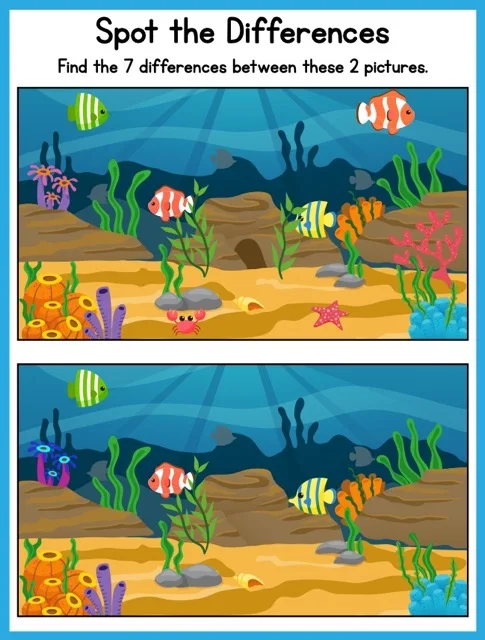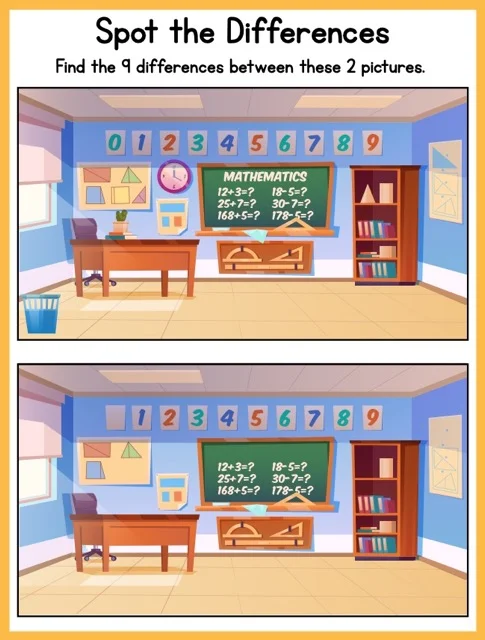Spot the Difference: A Visual Puzzle Game
Spot the Difference is a visual puzzle game where players identify subtle variations between two similar images. The game enhances observation skills, visual memory, and concentration. It's adaptable to various formats (print and digital) and difficulty levels, appealing to a wide audience, particularly young children, due to its colorful themes (e.g., transportation, space, mythical creatures). The game can be played individually or collaboratively, promoting both competition and teamwork, and its core concept has creative applications beyond traditional puzzles.
Spot the Difference: A Comprehensive Guide
Briefing Doc: Spot the Difference Puzzles
Overview: This briefing doc analyzes the key aspects of "Spot the Difference" puzzles, drawing information from a comprehensive guide and a set of themed puzzle examples.
What is "Spot the Difference"?
"Spot the Difference" is a visual puzzle game where players must identify subtle variations between two nearly identical images. As stated in the guide, "The challenge is to find all the subtle differences between the pictures." ("Spot the Difference: A Comprehensive Guide"). Players achieve this by carefully comparing elements in both images, looking for discrepancies in:
●
Color: Objects might change color or shade between images.
●
Size: Elements can be slightly larger or smaller in one image.
●
Position: Objects may shift their location or orientation.
●
Presence/Absence: Items might be added or removed entirely.
Benefits of Playing:
Beyond entertainment, "Spot the Difference" offers various cognitive benefits:
●
Enhances observation skills: The game trains players to pay close attention to minute details.
●
Improves visual memory: Players must retain details from one image while comparing it to the other.
●
Boosts concentration: Sustained focus is crucial for success.
The guide explicitly states that the game "sharpens observation skills, enhances attention to detail, and improves visual memory." ("Spot the Difference: A Comprehensive Guide").
Theme and Audience:
The use of diverse themes expands the game's appeal. Themes can range from animals, nature, and fantasy to everyday objects, catering to a wide variety of interests.
The provided examples ("Testing Theme: Spot the Differences.pdf") predominantly feature themes like:
●
Transportation (cars, trucks, planes)
●
Space (planets, rockets)
●
Construction (buildings, tools)
●
Weather (rainbows, storms)
●
Mythical Creatures (unicorns)
The colorful, playful imagery and the choice of themes suggest a target audience of young children, possibly in preschool or early elementary school. This is further supported by the guide which says, "Simple images with fewer differences are suitable for younger children" ("Spot the Difference: A Comprehensive Guide").
Game Format and Difficulty:
"Spot the Difference" can be enjoyed in various formats:
●
Traditional (print): Found in books, magazines, and activity sheets.
●
Digital: Available as online games and apps, often with interactive features.
The difficulty can be adjusted by manipulating the complexity of the images and the number of differences.
The provided examples utilize a vertical arrangement of images, which "encourages players to scan the images systematically, starting from the top and working their way down." This arrangement can aid in focus and organization.
Social Aspects:
The game can be enjoyed individually or as a social activity. Players can:
●
Compete: See who spots the differences fastest.
●
Collaborate: Work together to find all discrepancies.
This fosters teamwork and communication skills.
Creative Potential:
The concept of "Spot the Difference" extends beyond traditional puzzle formats. The core idea of finding subtle differences can be applied to:
●
Other forms of media: Photography, film, animation
●
Artistic expression: Drawing, painting, sculpture
Conclusion:
"Spot the Difference" is a versatile and engaging activity that offers entertainment and cognitive benefits. By understanding the key elements of game mechanics, themes, and audience targeting, we can leverage the power of "Spot the Difference" for educational purposes, artistic expression, and pure enjoyment.
Spot the Difference: A Comprehensive Guide
Spot the Difference FAQ
1. What is "Spot the Difference"?
"Spot the Difference" is a classic visual puzzle game where two nearly identical images are presented side-by-side. The challenge is to find all the subtle differences between the pictures.
2. How do you play "Spot the Difference"?
Carefully examine both images, comparing each element to its counterpart in the other image. Look for changes in color, size, position, or the absence/addition of objects. Once you spot a difference, you can mark it (depending on the game format).
3. What are the benefits of playing "Spot the Difference"?
"Spot the Difference" is a fun activity that also sharpens observation skills, enhances attention to detail, and improves visual memory. It's a great way to exercise your brain and boost concentration.
4. Are there different themes for "Spot the Difference"?
Absolutely! "Spot the Difference" puzzles can feature a wide range of themes, from animals and nature scenes to fantasy worlds and everyday objects. This keeps the game interesting and caters to different interests.
5. What age group is "Spot the Difference" suitable for?
"Spot the Difference" can be enjoyed by people of all ages, from young children to adults. The difficulty level can be adjusted by the complexity of the images and the number of differences.
6. Can "Spot the Difference" be played with others?
Yes, "Spot the Difference" can be a fun and engaging group activity. Players can compete to see who finds the differences fastest or work collaboratively to find all the changes.
7. Are there online versions of "Spot the Difference"?
Yes, there are numerous websites and apps that offer "Spot the Difference" games. These digital versions often provide interactive features, such as highlighting the differences when you find them.
8. Can I create my own "Spot the Difference" puzzles?
Certainly! You can create your own "Spot the Difference" puzzles using image editing software or even by drawing and making subtle changes between two copies of a picture. This can be a fun and creative activity.
Spot the Difference: A Comprehensive Guide
Spot the Difference: Study Guide
Short-Answer Quiz
Instructions: Answer each question in 2-3 sentences.
1.
What is the primary objective in a "Spot the Difference" game?
2.
Besides entertainment, what are two cognitive benefits of playing "Spot the Difference"?
3.
How does the theme of "Spot the Difference" puzzles contribute to player engagement?
4.
Briefly explain how the difficulty of "Spot the Difference" puzzles can be adapted for different audiences.
5.
In what ways can "Spot the Difference" be enjoyed as a social activity?
6.
What are the advantages of playing "Spot the Difference" online?
7.
If you were designing your own "Spot the Difference" puzzle, what tools or techniques could you utilize?
8.
Looking at the examples provided in "Testing Theme: Spot the Differences.pdf," what themes are represented in the puzzles?
9.
What could be inferred about the target audience for the puzzles provided in "Testing Theme: Spot the Differences.pdf"?
10.
Based on the "Testing Theme" examples, how does the arrangement of the images on the page impact gameplay?
Answer Key
1.
The primary objective in "Spot the Difference" is to identify all the subtle variations between two nearly identical images. Players must carefully compare each element of the pictures to find discrepancies in color, size, position, or the presence/absence of objects.
2.
Playing "Spot the Difference" enhances observation skills by training players to notice minute details. It also improves visual memory as players need to retain the features of one image while comparing it to the other. Additionally, it boosts concentration as sustained focus is required to spot the differences.
3.
The use of diverse themes in "Spot the Difference" puzzles ensures the game appeals to a wider range of players. By featuring themes like animals, nature, fantasy, or everyday objects, the puzzles cater to different interests and preferences, making them more engaging for individual players.
4.
The difficulty of "Spot the Difference" puzzles is adjustable by manipulating the complexity of the images and the number of differences. Simple images with fewer differences are suitable for younger children, while more intricate images with multiple subtle changes would challenge adults.
5.
"Spot the Difference" can be a fun group activity where players can compete to see who spots the differences fastest. It can also encourage collaborative play where participants work together to find all the discrepancies, fostering teamwork and communication.
6.
Online "Spot the Difference" games offer interactive features, such as highlighting the differences when found, providing immediate feedback to the player. Digital platforms also offer a wider variety of themes and difficulty levels, and often incorporate scoring systems or timers to add an element of competition.
7.
To create a "Spot the Difference" puzzle, you could use image editing software to duplicate an image and then make subtle changes to one version. Alternatively, you could draw two nearly identical pictures by hand, intentionally introducing minor variations.
8.
The "Testing Theme" examples showcase themes related to transportation, space, construction, weather, and mythical creatures (like unicorns). This suggests a focus on themes that might appeal to a younger audience.
9.
Based on the colorful and playful imagery used in the "Testing Theme" examples, the target audience is likely young children, possibly in preschool or early elementary school.
10.
The vertical arrangement of the images in the "Testing Theme" examples encourages players to scan the images systematically, starting from the top and working their way down. This could help with focus and organization during gameplay.
Essay Questions
1.
Discuss the cognitive processes involved in playing "Spot the Difference," focusing on the interplay between visual perception, attention, and memory.
2.
Analyze the impact of different themes in "Spot the Difference" puzzles on player engagement and motivation. Explain how the selection of themes can influence the appeal of the game for various demographics.
3.
Evaluate the potential educational benefits of incorporating "Spot the Difference" activities into classroom settings for different age groups. Discuss how these puzzles can contribute to the development of specific skills and learning outcomes.
4.
Compare and contrast the experience of playing "Spot the Difference" in traditional (print) versus digital formats. Consider the advantages and limitations of each format in terms of accessibility, interactivity, and engagement.
5.
Explore the creative possibilities of "Spot the Difference" beyond its traditional puzzle format. Discuss how the concept of finding subtle differences could be applied to other forms of media or artistic expression.
Glossary of Key Terms
●
Spot the Difference: A visual puzzle game that challenges players to find subtle variations between two nearly identical images.
●
Visual Perception: The process of interpreting and understanding visual information received through the eyes.
●
Attention: The ability to focus on specific stimuli while filtering out distractions.
●
Visual Memory: The ability to store and recall visual information, such as the appearance of objects or scenes.
●
Theme: A unifying subject or idea that runs through a work of art, literature, or entertainment, such as animals, nature, fantasy, or everyday objects in "Spot the Difference" puzzles.
●
Interactive Features: Elements in digital games or applications that respond to user input, such as highlighting the differences in an online "Spot the Difference" game.
●
Cognitive Benefits: Positive effects on mental processes, such as improved observation skills, enhanced attention to detail, and strengthened visual memory.
●
Difficulty Level: A measure of the challenge posed by a game or activity, which can be adjusted in "Spot the Difference" puzzles by varying the complexity of images and the number of differences.
●
Target Audience: The specific group of people for whom a product, service, or message is intended, such as young children being the target audience for certain "Spot the Difference" puzzles.
























